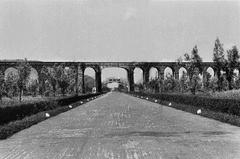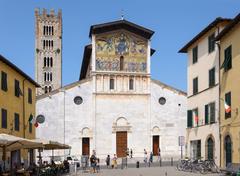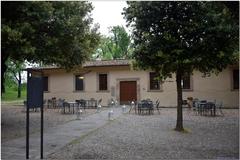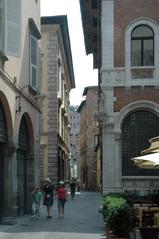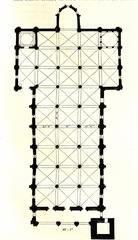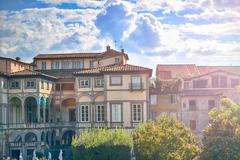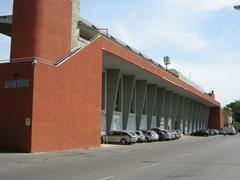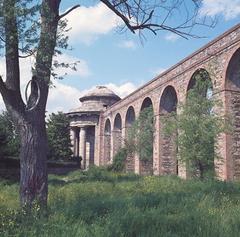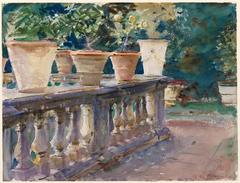Comprehensive Guide to Visiting Piazza Dell’Anfiteatro, Lucca, Italy
Date: 16/08/2024
Introduction
Nestled in the heart of Lucca, Italy, Piazza dell’Anfiteatro is a remarkable testament to the city’s rich historical tapestry. This iconic square, renowned for its unique elliptical shape, has undergone a fascinating evolution from its origins as a grand Roman amphitheater to a vibrant, modern-day hub. Constructed in the 1st century during the reign of Emperor Claudius, the amphitheater initially served as a central venue for public gatherings, games, and events (Tuscany.co). Over the centuries, it has been repurposed and transformed, reflecting the city’s dynamic history and cultural shifts (Atlas Obscura). Today, Piazza dell’Anfiteatro stands as a living monument, seamlessly blending ancient and modern architectural elements and serving as a bustling center for social and cultural activities (Visit Tuscany). This guide provides an in-depth exploration of the piazza’s history, architectural features, cultural significance, and practical information for visitors, making it an essential read for anyone planning a visit to Lucca.
Table of Contents
- Introduction
- History and Significance
- Architectural Features
- Cultural Significance
- Modern-Day Relevance
- Visitor Information
- Travel Tips
- Nearby Attractions
- FAQ Section
- Conclusion
- References
History and Significance
Roman Origins
Piazza Dell’Anfiteatro, located in the heart of Lucca, Italy, is a site steeped in history, dating back to the Roman era. The original amphitheater was constructed in the 1st century during the reign of Emperor Claudius. This grand structure featured fifty-four arches and could accommodate nearly ten thousand spectators, making it a central hub for public gatherings, games, and events (Tuscany.co).
Medieval Transformation
As the Roman Empire declined, the amphitheater fell into disuse and disrepair. By the Middle Ages, the structure had been repurposed. The open space of the arena, known as ‘parlascio’—a derivative of the Latin word ‘paralisium’ (amphitheater)—became a venue for public meetings. Over time, buildings were constructed around the perimeter, enclosing the space and giving rise to the piazza as it is known today (Tuscany.co).
Renaissance Revival
The 19th century marked a significant period of transformation for Piazza Dell’Anfiteatro. Architect Lorenzo Nottolini was commissioned to revive the piazza based on the ancient Roman ruins. Nottolini’s design preserved the elliptical shape of the original amphitheater, creating a spacious urban center that served as a market and social gathering place. His work ensured that the piazza retained its historical significance while adapting to contemporary needs (Tuscany.co).
20th Century and Beyond
At the beginning of the 20th century, the central market, which had been a staple of the piazza, was relocated to another part of the city. Despite this change, the piazza continued to be known locally as Piazza del Mercato (Market Square), reflecting its historical role as a commercial hub. Today, the piazza remains a vibrant center of activity, attracting both locals and tourists alike (Tuscany.co).
Architectural Features
Elliptical Shape
One of the most striking features of Piazza Dell’Anfiteatro is its elliptical shape, a direct homage to the Roman amphitheater on which it was built. Visitors entering the piazza do so through one of four doorways, with only the lowest doorway being part of the original Roman structure. The floor of the piazza is nearly three feet higher than that of the ancient arena, a result of centuries of construction and renovation (Tuscany.co).
Four Gateways
Access to the piazza is provided through four gateways, each located at one of the vertices of the ellipse. These gateways are remnants of the original entrances to the Roman amphitheater, playing a crucial role in maintaining the historical integrity of the site. The central tile of the piazza features a carved cross, with its arms pointing toward the four gateways, symbolizing the connection between the past and present (Nomads Travel Guide).
Integration of Ancient and Modern Elements
One of the most fascinating aspects of Piazza dell’Anfiteatro is the seamless integration of ancient and modern architectural elements. The buildings surrounding the piazza incorporate parts of the original Roman structure, including vaults and arches. This blending of historical and contemporary features creates a dynamic and layered architectural landscape that reflects the site’s long and varied history (Atlas Obscura).
Cultural Significance
The piazza is more than just an architectural marvel; it is a living testament to the city’s rich history. The cross engraved into the floor at the intersection of the four entryways serves as a symbolic reminder of the site’s historical and cultural layers. The remains of the old amphitheater can still be seen just beyond the walls of the piazza, offering a tangible connection to the past (Tuscany.co).
Modern-Day Relevance
Today, Piazza Dell’Anfiteatro is a bustling center of activity, hosting various events, markets, and social gatherings. Its unique blend of historical significance and contemporary relevance makes it a must-visit destination for anyone traveling to Lucca. The piazza’s vibrant atmosphere, coupled with its rich history, offers visitors a unique glimpse into the city’s past and present (Tuscany.co).
Visitor Information
Visiting Hours
Piazza Dell’Anfiteatro is a public space and is open 24/7, but individual shops and restaurants have varying hours.
Tickets
There is no entrance fee to visit the piazza itself. However, some events or attractions within the piazza may have separate charges.
Accessibility
The piazza is accessible to visitors with mobility impairments, with paved walkways and ramps available.
Travel Tips
Entry Points
Access the piazza through one of its four doorways. The lowest doorway is part of the original Roman structure, offering a direct link to the past.
Historical Markers
Look for the cross engraved into the floor at the intersection of the entryways, a significant historical marker.
Elevation
Note that the floor of the piazza is nearly three feet higher than the ancient arena, a result of centuries of construction.
Local Flavor
Enjoy the vibrant atmosphere by visiting the various shops, cafes, and restaurants that line the piazza.
Cultural Events
Check the local calendar for events and markets that may be taking place during your visit.
Nearby Attractions
Lucca Cathedral
A stunning example of Romanesque architecture, located just a short walk from the piazza.
Guinigi Tower
Climb to the top for breathtaking views of Lucca and its surroundings.
Church of San Michele in Foro
An impressive church with a richly decorated facade, situated in another historic piazza.
FAQ Section
What are the opening hours of Piazza Dell’Anfiteatro?
Piazza Dell’Anfiteatro is open to the public 24/7, but individual establishments within the piazza have varying hours.
Is there an entrance fee for Piazza Dell’Anfiteatro?
No, there is no entrance fee to visit the piazza itself, though some events or attractions may require tickets.
How can I access Piazza Dell’Anfiteatro?
The piazza can be accessed through any of its four doorways, with the lowest doorway being part of the original Roman structure.
Conclusion
By understanding the rich history and significance of Piazza Dell’Anfiteatro, visitors can fully appreciate the depth and beauty of this remarkable site. Whether you’re a history buff, an architecture enthusiast, or simply looking to soak in the local culture, Piazza Dell’Anfiteatro offers something for everyone. Don’t forget to explore nearby attractions and immerse yourself in the vibrant atmosphere of Lucca. For more travel tips and updates, follow us on social media and check out our other related posts.
References
- Tuscany.co. (n.d.). Sightseeing in Lucca: Piazza dell’Anfiteatro. https://www.tuscany.co/sightseeing-lucca/piazza-anfiteatro.html
- Atlas Obscura. (n.d.). Piazza dell’Anfiteatro. https://www.atlasobscura.com/places/piazza-dell-anfiteatro
- Visit Tuscany. (n.d.). Roman Amphitheatre: Piazza dell’Anfiteatro. https://www.visittuscany.com/en/attractions/roman-amphitheatre-piazza-dellanfiteatro/
